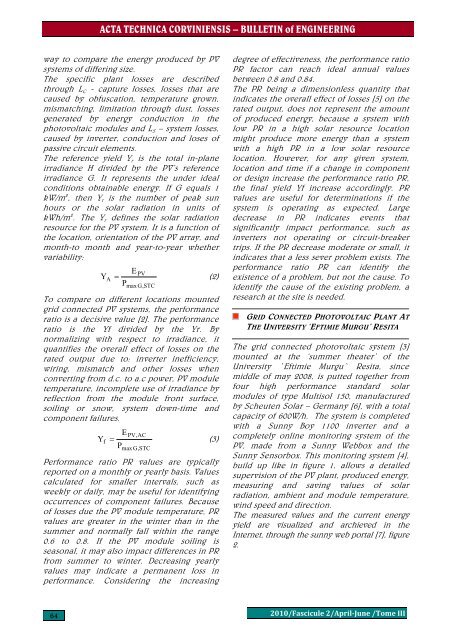ACTA TECHNICA CORVINIENSIS - Bulletin of Engineering
ACTA TECHNICA CORVINIENSIS - Bulletin of Engineering
ACTA TECHNICA CORVINIENSIS - Bulletin of Engineering
- No tags were found...
You also want an ePaper? Increase the reach of your titles
YUMPU automatically turns print PDFs into web optimized ePapers that Google loves.
<strong>ACTA</strong> <strong>TECHNICA</strong> <strong>CORVINIENSIS</strong> – BULLETIN <strong>of</strong> ENGINEERINGway to compare the energy produced by PVsystems <strong>of</strong> differing size.The specific plant losses are describedthrough L C - capture losses, losses that arecaused by obfuscation, temperature grown,mismatching, limitation through dust, lossesgenerated by energy conduction in thephotovoltaic modules and L S – system losses,caused by inverter, conduction and loses <strong>of</strong>passive circuit elements.The reference yield Y r is the total in-planeirradiance H divided by the PV’s referenceirradiance G. It represents the under idealconditions obtainable energy. If G equals 1kW/m 2 , then Y r is the number <strong>of</strong> peak sunhours or the solar radiation in units <strong>of</strong>kWh/m 2 . The Y r defines the solar radiationresource for the PV system. It is a function <strong>of</strong>the location, orientation <strong>of</strong> the PV array, andmonth-to month and year-to-year whethervariability:E PVY A = (2)PmaxG,STCTo compare on different locations mountedgrid connected PV systems, the performanceratio is a decisive value [2]. The performanceratio is the Yf divided by the Yr. Bynormalizing with respect to irradiance, itquantifies the overall effect <strong>of</strong> losses on therated output due to: inverter inefficiency,wiring, mismatch and other losses whenconverting from d.c. to a.c power, PV moduletemperature, incomplete use <strong>of</strong> irradiance byreflection from the module front surface,soiling or snow, system down-time andcomponent failures.E PV,ACY f = (3)Pmax G,STCPerformance ratio PR values are typicallyreported on a monthly or yearly basis. Valuescalculated for smaller intervals, such asweekly or daily, may be useful for identifyingoccurrences <strong>of</strong> component failures. Because<strong>of</strong> losses due the PV module temperature, PRvalues are greater in the winter than in thesummer and normally fall within the range0.6 to 0.8. If the PV module soiling isseasonal, it may also impact differences in PRfrom summer to winter. Decreasing yearlyvalues may indicate a permanent loss inperformance. Considering the increasingdegree <strong>of</strong> effectiveness, the performance ratioPR factor can reach ideal annual valuesbetween 0.8 and 0.84.The PR being a dimensionless quantity thatindicates the overall effect <strong>of</strong> losses [5] on therated output, does not represent the amount<strong>of</strong> produced energy, because a system withlow PR in a high solar resource locationmight produce more energy than a systemwith a high PR in a low solar resourcelocation. However, for any given system,location and time if a change in componentor design increase the performance ratio PR,the final yield Yf increase accordingly. PRvalues are useful for determinations if thesystem is operating as expected. Largedecrease in PR indicates events thatsignificantly impact performance, such asinverters not operating or circuit-breakertrips. If the PR decrease moderate or small, itindicates that a less sever problem exists. Theperformance ratio PR can identify theexistence <strong>of</strong> a problem, but not the cause. Toidentify the cause <strong>of</strong> the existing problem, aresearch at the site is needed.GRID CONNECTED PHOTOVOLTAIC PLANT ATTHE UNIVERSITY ‘EFTIMIE MURGU’ RESITAThe grid connected photovoltaic system [3]mounted at the ‘summer theater’ <strong>of</strong> theUniversity `Eftimie Murgu` Resita, sincemiddle <strong>of</strong> may 2008, is putted together fromfour high performance standard solarmodules <strong>of</strong> type Multisol 150, manufacturedby Scheuten Solar – Germany [6], with a totalcapacity <strong>of</strong> 600W/h. The system is completedwith a Sunny Boy 1100 inverter and acompletely online monitoring system <strong>of</strong> thePV, made from a Sunny Webbox and theSunny Sensorbox. This monitoring system [4],build up like in figure 1, allows a detailedsupervision <strong>of</strong> the PV plant, produced energy,measuring and saving values <strong>of</strong> solarradiation, ambient and module temperature,wind speed and direction.The measured values and the current energyyield are visualized and archieved in theInternet, through the sunny web portal [7], figure2.642010/Fascicule 2/AprilJune /Tome III
















